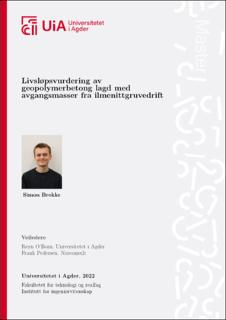| dc.description.abstract | Global CO2 emissions from cement production represent a major challenge on the path towards a future of net zero emissions. Alternative concrete binders are therefore being developed, and one such binder is called geopolymer cement. Mixing industrial wastes and an alkaline solution, such as sodium or potassium hydroxide, the cement can completely replace ordinary portland cement in concrete. The Norwegian company Saferock are developing a new geopolymer cement which utilises mine tailings from ilmenite production, together with potassium hydroxide. Today, millions of tons of mine tailings are deposited in Sokndal, and this is a major environmental concern. The purpose of this master's thesis is to evaluate the environmental impacts of Saferock's geopolymer cement. This is done by using life cycle assessment (LCA) to quantify the emissions that come from producing the geopolymer cement and concrete. The research question is: what are the environmental impacts of geopolymer concrete made with tailings from ilmenite mining?
The results of the LCA study show that the CO2 emissions from the geopolymer concrete are exactly half of those of a comparable standard concrete. The potassium hydroxide accounts for 90% of the emissions; however the background data on the emissions from this process are insufficient. It is recommended that Saferock acquire potassium hydroxide produced using renewable resources in order to further reduce their emissions. An LCA study was also carried out on a school building in Ørsta to compare the impacts of different building materials. The school was modelled in standard concrete, geopolymer concrete and cross-laminated timber, and was then analysed. The timber version performed best, and the standard concrete performed worst. Overall, however, the total emissions were not that different from each other, due to high emissions from other building components, such as steel columns, insulation and windows. | |
